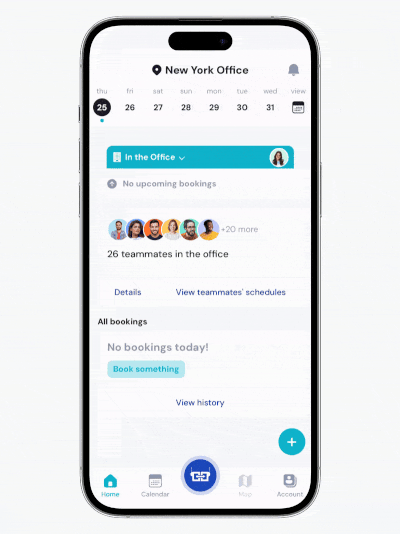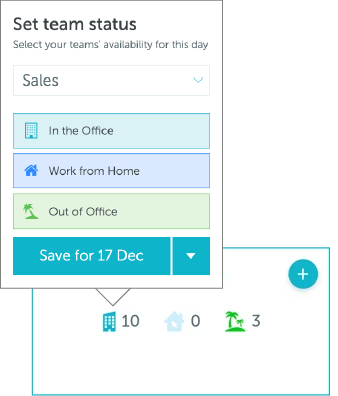







One calendar, full visibility.
Dive into our quick interactive demo - no sign-up, just click and explore. See how simple hybrid work scheduling can be.
How does hybrid work software work?
Open the work statuses calendar
Begin by accessing your hybrid work statuses calendar through the YAROOMS Workplace Experience Platform. This tool is your gateway to organizing a balanced and efficient hybrid work schedule.
Create your hybrid work schedule
Select your work location preferences—whether in the office, at home, or elsewhere—for the upcoming day, week, or month. Ensure that you save your schedule once it is finalized.
Book desks for days in the office
Based on your hybrid work status, book desks or other workspaces for the days you'll work at the office. This helps make sure your workday goes smoothly and you stay productive.
HYBRID WORK PLANNING
All hybrid work statuses in one calendar view
YAROOMS work statuses calendar is an easy-to-use hybrid work tool tailored to support flexible scheduling in your organization.
Define planning targets or work-from-home thresholds, align scheduling with occupancy parameters, and ensure planning visibility to everyone in the organization. All of it - while maintaining employee autonomy to schedule their own time, resources, and space in the office.
HYBRID WORK PLANNING
All hybrid work statuses in one calendar view
YAROOMS work statuses calendar is an easy-to-use hybrid work tool tailored to support flexible scheduling in your organization.
Define planning targets or work-from-home thresholds, align scheduling with occupancy parameters, and ensure planning visibility to everyone in the organization. All of it - while maintaining employee autonomy to schedule their own time, resources, and space in the office.
%20(1).png?width=2000&name=calendar%20view-work%20statuses%20(1)%20(1).png)

Autonomous scheduling
Team members can create the preferred hybrid work schedule on their own. If needed, group managers can set statuses in bulk on behalf of their teams.
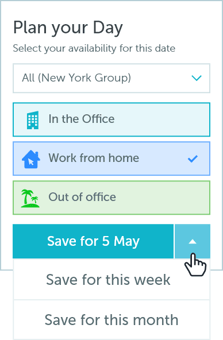
Scheduling intervals
Employees can save their hybrid work statuses for a day, a week, or a month.
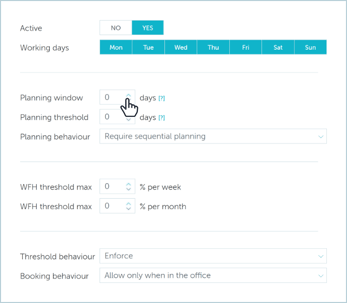
Custom settings and thresholds
Workplace managers can set rules for how far in advance a group needs to set their work statuses and how many days they can work from home.
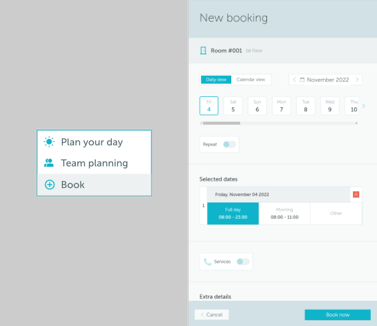
Workpace booking
Employees can book desks, meeting rooms, or even a parking lots for the days at the office, and see what their team members have booked.
Kianusch Sayah Karadji
Technical Solution Manager
"With the relocation to the new office, we left behind everything we did not need anymore: from furniture to working arrangements. We were ready for a new, hybrid workplace, where employees can choose where they prefer to work—at home or in the office. YAROOMS hybrid work software helped us to put it into practice."
SPACE MANAGEMENT
Workspace booking for a streamlined hybrid work environment
Powerful booking software is a key tool for facilitating collaboration in the hybrid work model. It streamlines workspace reservations and offers a real-time overview of availability when employees choose to work in the office.
With YAROOMS, all office spaces—from rooms and desks to parking spots—are easily bookable. The solution features an interactive floor map and supports different booking strategies (hot desking, desk hoteling, assigned seating). It's a useful work tool for location managers, allowing them to enforce capacity limitations, facilitate check-in procedures, track utilization analytics, and more.
SPACE MANAGEMENT
Workspace booking for a streamlined hybrid work environment
Powerful booking software is a key tool for facilitating collaboration in the hybrid work model. It streamlines workspace reservations and offers a real-time overview of availability when employees choose to work in the office.
With YAROOMS, all office spaces—from rooms and desks to parking spots—are easily bookable. The solution features an interactive floor map and supports different booking strategies (hot desking, desk hoteling, assigned seating). It's a useful work tool for location managers, allowing them to enforce capacity limitations, facilitate check-in procedures, track utilization analytics, and more.


MICROSOFT TEAMS INTEGRATION
Your hybrid workplace software, in Teams
Integrating hybrid work technology is an excellent way to boost end-user experience and increase user adoption. When hybrid workplace tools are interoperable, efficiency and productivity are greatly enhanced.
YAROOMS hybrid workplace software integrates with Microsoft Teams enabling users to schedule and manage their work directly from the Teams platform, improving collaboration and productivity. Simply install YAROOMS as a Teams personal ribbon app and make it available to your entire user base in minutes.
MICROSOFT TEAMS INTEGRATION
Your hybrid workplace software, in Teams
Integrating hybrid work technology is an excellent way to boost end-user experience and increase user adoption. When hybrid workplace tools are interoperable, efficiency and productivity are greatly enhanced.
YAROOMS hybrid workplace software integrates with Microsoft Teams enabling users to schedule and manage their work directly from the Teams platform, improving collaboration and productivity. Simply install YAROOMS as a Teams personal ribbon app and make it available to your entire user base in minutes.
.png?width=1485&height=990&name=yarooms%20%26%20Teams@0.33x%20(1).png)
.png?width=1485&height=990&name=yarooms%20%26%20Teams@0.33x%20(1).png)
YAROOMS MOBILE
Mobile application for on-the-go scheduling
YAROOMS hybrid work software is also available through a mobile app, creating a modern employee experience hub that allows scheduling from anywhere, whether in the office or working remotely.
Easily navigate the office using an interactive floor map, quickly find and book spaces with the amenities you need, and view all your upcoming reservations at a glance. This makes it easier to collaborate and stay organized in a hybrid work environment.
YAROOMS MOBILE
Mobile application for on-the-go scheduling
YAROOMS hybrid work software is also available through a mobile app, creating a modern employee experience hub that allows scheduling from anywhere, whether in the office or working remotely.
Easily navigate the office using an interactive floor map, quickly find and book spaces with the amenities you need, and view all your upcoming reservations at a glance. This makes it easier to collaborate and stay organized in a hybrid work environment.

THE YAROOMS EXPERIENCE
Onboarding & support to set your hybrid work model for success
Our commitment to getting things done sets us apart from other hybrid work software providers. From Day 1, we are dedicated to delivering the best YAROOMS experience, ensuring you have everything you need to succeed in the world of hybrid.
✓ Fast-track & high-touch onboarding options to help you kickstart with hybrid workplace software.
✓ 24/5 customer support available across all time zones.
✓ An experienced onboarding & support team with a broad knowledge about hybrid work models.
THE YAROOMS EXPERIENCE
Onboarding & support to set your hybrid work model for success
Our commitment to getting things done sets us apart from other hybrid work software providers. From Day 1, we are dedicated to delivering the best YAROOMS experience, ensuring you have everything you need to succeed in the world of hybrid.
✓ Fast-track & high-touch onboarding options to help you kickstart with hybrid workplace software.
✓ 24/5 customer support available across all time zones.
✓ An experienced onboarding & support team with a broad knowledge about hybrid work models.


Bree El Fattal
Sr. Facilities Manager
"The YAROOMS onboarding & support team was extremely accommodating with all our customizations and continues to be very attentive to our change requests. Even though YAROOMS’ primary support is out of country, they attended every meeting with us. Being out of country had zero impact on delivering the hybrid workplace solution on time."
Insights to get you started
Choosing the right hybrid work software is no small feat.
We collected a couple of insightful resources to help you identify your needs and navigate the sea of options. Continue your research:
Hybrid workplace software: FAQ
What is hybrid work software?
What are the benefits of hybrid work software?
Hybrid work software, designed to facilitate a blend of remote and in-office work, offers many benefits for organizations and their employees. These tools are pivotal in creating a flexible, inclusive, and productive hybrid work environment. Here are some key benefits:
- Enhanced Flexibility: Employees can choose where they work from, allowing them to create a work-life balance that suits their personal and professional needs.
- Increased Productivity: By allowing employees to work in environments where they feel most comfortable and focused, hybrid work software can lead to higher productivity levels.
- Improved Communication: These platforms offer various communication tools (chat, video conferencing, and collaboration spaces) that keep teams connected, regardless of physical location.
- Access to a Broader Talent Pool: Organizations are not limited to hiring talent in specific geographic locations, enabling them to recruit from a global pool.
- Cost Savings: Businesses can reduce costs associated with maintaining large office spaces, as not all employees will be in the office simultaneously.
- Sustainability: With fewer people commuting daily, reducing carbon footprints has a positive impact, contributing to environmental sustainability.
- Workforce Diversity: Hybrid models make the workplace more accessible for people who may face barriers to traditional office-based work, such as those with disabilities or caregiving responsibilities, thus promoting diversity.
- Employee Well-being: The flexibility offered by hybrid work can improve mental health and lower stress levels, as employees can work in ways that best suit their needs.
What is the best hybrid work software?
What technology is needed for hybrid work?
A strong technological infrastructure, including advanced planning and space management tools, is key to a seamless hybrid work model.
Cloud-based platforms like Google Workspace and Slack enable real-time and asynchronous collaboration, allowing remote employees and in-office teams to work together efficiently. Communication tools such as video conferencing help maintain personal connections, while project management and hybrid work calendars keep tasks and schedules organized.
Hybrid work software (like YAROOMS), integrated with workspace booking tools, optimizes office space, enhances collaboration, and ensures clear schedule visibility. Employees can easily reserve workspaces, while security tools like VPNs protect sensitive data. Reliable high-speed internet supports these technologies and maintains productivity in a hybrid work environment.
What is a hybrid work model?
What is a hybrid work schedule?
How do you create a hybrid work schedule?
To create an effective hybrid work schedule, use tools like Yarooms hybrid workplace software to balance in-office and remote work in the hybrid workplace model.
Set core in-office days for team collaboration while allowing employees to choose remote work days. Employees can use the hybrid work software to book desks, reserve meeting spaces, and see when coworkers are on-site, ensuring seamless workflows and collaboration. Clear schedule input and flexibility guidelines are crucial to maintaining productivity and satisfaction.
This approach fosters autonomy while keeping teams connected and productive in a hybrid work environment.
What are the pros and cons of hybrid work?
The hybrid work model offers numerous benefits for organizations and employees:
- Flexibility: Employees can choose between remote and in-office work, boosting satisfaction and work-life balance.
- Increased Employee Satisfaction: Hybrid employees are often more satisfied than those who work exclusively on-site or remotely.
- Access to a Broader Talent Pool: Companies can hire top talent without location limits.
- Cost Savings: Less office space is needed, reducing rental costs.
However, there are some hybrid work challenges to consider:
- Increased Reliance on Technology: Hybrid work depends on digital tools like Slack for real-time collaboration, which can lead to higher cyber risks.
- Weakened Team Relationships: Digital communication may make it harder for coworkers to maintain strong connections.
How do you manage a hybrid workforce?
The best way to manage a hybrid workforce is by implementing hybrid work processes and policies, as well as embracing technology that allows everyone to be productive regardless of their chosen location of work.
For employers, hybrid work offers a solution to appease their entire workforce. It emphasizes employee autonomy and flexibility, enabling them to work in an environment that makes them feel the best.
How do you hold a hybrid meeting?
To hold a successful hybrid meeting, investing in quality technology and the right tools to support the hybrid work model is essential. Equip your meeting rooms with high-quality video conferencing systems, microphones, and interactive whiteboards to ensure remote and in-office employees can collaborate seamlessly.
Integrating platforms like Microsoft Teams and Slack allows for real-time communication and document sharing, optimizing the experience for all participants.
Automation and intuitive interfaces in meeting room scheduling software can further streamline the process, making it easy for employees to coordinate meetings, book spaces, and connect across locations. This approach enhances productivity and ensures that hybrid work model meetings run smoothly, keeping everyone engaged and aligned, regardless of where they work.



